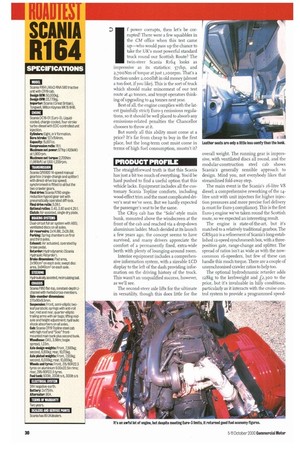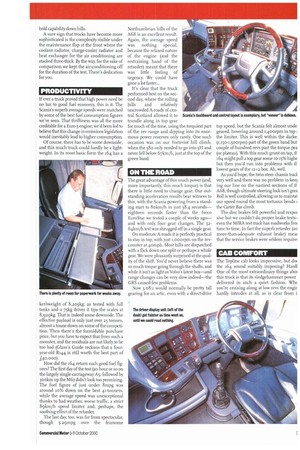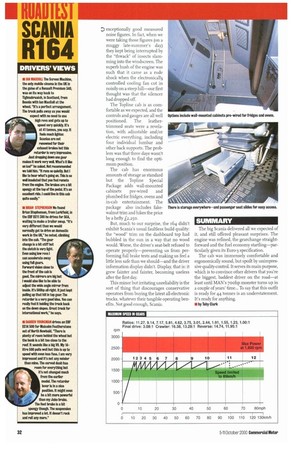f power corrupts, then let's be cor rupted! There were a few squabbles in
Page 34

Page 35

Page 36

If you've noticed an error in this article please click here to report it so we can fix it.
the CM office when this test came
up—who would pass up the chance to take the UK's most powerful standard truck round our Scottish Route? The twin-steer Scania R164 looks as impressive as its statistics: 571hp, and 2,700Nm of torque at just 1,100rpm. That's a fraction under 2.,000lbft in old money (almost a ton-foot, if you like). This is the sort of truck which should make mincemeat of our test route at 41 tonnes, and tempt operators thinking of upgrading to 44 tonnes next year.
Best of all, the engine complies with the latest (painfully strict) Euro-3 emissions regulations, so it should be well placed to absorb any emissions-related penalties the Chancellor chooses to throw at it.
But surely all this ability must come at a price? It's far from cheap to buy in the first place, but the long-term cost must come in terms of high fuel consumption, mustn't it?
PRODUCT PROFILE
The straightforward truth is that this Scania has just a bit too much of everything. You'd be hard pushed to find a useful option that this vehicle lacks. Equipment includes all the customary Scania Topline comforts, including wood-effect trim and the most complicated driver's seat we've seen. But we hardly expected the passenger's seat to be the same.
The CR19 cab has the "Solo"-style main bunk, mounted above the windscreen at the front of the cab and reached via a drop-down aluminium ladder. Much derided at its launch a few years ago, the concept seems to have survived, and many drivers appreciate the comfort of a permanently fixed, extra-wide berth with plenty of lounging-around room.
Interior equipment includes a comprehensive information system, with a sizeable LCD display to the left of the dash providing information on the driving history of the truck. This wasn't an unqualified success, however, as we'll see.
The second-steer axle lifts for the ultimate in versatility, though this does little for the overall weight. The running gear is impressive, with ventilated discs all round, and the modular-construction steel cab shows Scania's generally sensible approach to design. Mind you, not everybody likes that streamlined fold-away step.
The main event is the Scania's 16-litre VS diesel; a comprehensive reworking of the 14litre unit with unit injectors for higher injection pressures and more precise fuel delivery (a must for Euro-3 compliance). This is the first Euro-3 engine we've taken round the Scottish route, so we expected an interesting result.
The engine is state-of-the-art, but it's matched to a relatively traditional gearbox. The GRS920 is a refinement of Scania's long-established 12-speed synchromesh box, with a threeposition gate, range-change and splitter. The spread of ratios isn't as wide as with the nowcommon r6-speeders, but few of these can handle this much torque. There are a couple of unsynchronised crawler ratios to help too.
The optional hydrodynamic retarder adds 128kg to the kerbweight and 12,300 to the price, but it's invaluable in hilly conditions, particularly as it interacts with the cruise control system to provide a programmed speed hold capability down hills.
A sure sign that trucks have become more sophisticated is the complexity visible under the maintenance flap at the front where the coolant radiator, charge-cooler radiator arid heat exchanger for the air conditioning are stacked three-thick. By the way, for the sake of comparison we kept the air-conditioning off for the duration of the test There's dedication for you.
PRODUCTIVITY
If ever a truck proved that high power need be no bar to good fuel economy, this is it. The Scania's superb average speeds were matched by some of the best fuel consumption figures we've seen. That thriftiness was all the more creditable for a Euro-3 engine; we'd been led to believe that this change in emissions legislation would inevitably lead to higher consumption.
Of course, there has to be some downside, and this much truck could hardly be a lightweight. In its most basic form the 164 has a kerbweight of 8,2o5kg; as tested with full tanks and a 75kg driver it tips the scales at 8,929kg. That is indeed some downside. The effective payload is only just over 25 tonnes, almost a tonne down on some of the competition. Then there's the formidable purchase price, but you have to expect that from such a monster, and the residuals are not likely to be too bad (Glass's Guide reckons that a fouryear-old Ri44 is still worth the best part of £40,000).
How did the 164 return such good fuel figures? The first day of the test (an hour or so on the largely single-carriageway As, followed by 300km up the MG) didn't look too promising. The fuel figure of just under 8mpg was around ro% down on the best 41-toriners, while the average speed was unexceptional thanks to bad weather, worse traffic, a strict 89km ih speed limiter and, perhaps, the soothing effect of the retarder.
The last day, too, was far from spectacular, though 5.29mpg over the fearsome Northumbrian hills of the A68 is an excellent result. Again, the average speed was nothing special, because the relaxed nature of the engine (and the restraining hand of the retarder) meant that there was little feeling of urgency. We could have gone a lot faster...
It's clear that the truck performed best on the second day, where the rolling hills and relatively uncrowded A-roads of central Scotland allowed it to trundle along in top gear for much of the time, using the torquiest part of the rev range and dipping into its enormous power reserves only rarely. One such occasion was on our Forteviot hill climb, when the 58o only needed to go into 5H and never fell below 67km/h, just at the top of the green band.
ON THE ROAD
The great advantage of this much power (and, more importantly, this much torque) is that there is little need to change gear. Our outstanding acceleration results bear witness to this, with the Scania powering from a standing start to 80km/h in just 38.4 seconds— eighteen seconds faster than the Iveco EuroStar we tested a couple of weeks ago— and with only four gear changes. The 3264km/h test was shrugged off in a single gear.
On moderate A-roads it is perfectly practical to stay in top, with just L000rpm on the revcounter at 40mph. Most hills are dispatched with a flick down one split or perhaps a whole gear. We were pleasantly surprised at the quality of the shift. You'd never believe there was so much torque going through the shafts, and while it isn't as light as Volvo's latest box—and range changes can be very slow indeed—the CRS caused few problems.
Now 3.08:1 would normally be pretty tall gearing for an artic, even with a direct-drive
top speed, but the Scania felt almost unde geared, hovering around 1,400rpm in top ; the limiter. This is well within the darke: (r,r50-r,soorpm) part of the green band but couple of hundred revs past the torque pea (or plateau). With this much grunt on tap, tl164 might pull a top gear some 10-15% highe but then you'd run into problems with lowest gears of the 12+2 box. Ah, well.
As you'd hope, the twin-steer chassis tracl very well and there was no problem in keel ing our line on the nastiest sections of tle A68, though ultimate steering lock isn't grea Roll is well controlled, allowing us to maintai our speed round the most tortuous bends the Carter Bar climb.
The disc brakes felt powerful and respoi sive but we couldn't do proper brake testseven the MIRA test track has roadworks fro' time to time. In fact the superb retarder (an more-than-adequate exhaust brake) meal that the service brakes were seldom require
CAB COMFORT
The Topline cab looks impressive, but do< the 164 sound suitably imposing? Hardl One of the most extraordinary things aboi this truck is that its sledgehammer power delivered in such a quiet fashion. Whe you're cruising along at low revs the engir hardly intrudes at all, as is clear from i
exceptionally good measured noise figures. In fact, when we were taking those figures (on a muggy late-summer's day) t4,_ they kept being interrupted by the "thwack" of insects slamming into the windscreen. The superb hush of the engine was such that it came as a rude shock when the electronicalls controlled cooling fan cut in noisily on a steep hill—our first thought was that the silencer had dropped off.
The Topline cab is as comfortable as we expected, and the controls and gauges are all welt positioned. The leathertrim rued seats were a revelation, with adjustable and/or electric everything, including four individual lumbar and other back supports. The problem was that three days wasn't long enough to find the optimum position.
The cab has enormous amounts of storage as standard but the Topline Special Package adds wall-mounted cabinets pre-wired and plumbed for fridges, ovens and in-cab entertainment. The package also includes fakewalnut trim and hikes the price by a hefty £2,250.
But, much to our surprise, the 164 didn't exhibit Scania's usual faultless build quality: the "wood" trim on the dashboard top had bubbled in the sun in a way that no wood would. Worse, the driver's seat-belt refused to operate properly—preventing us from performing full brake tests and making us feel a little less safe than we should—and the driver information display didn't. Display, that is: it grew fainter and fainter, becoming useless after the first day.
This minor but irritating unreliability is the sort of thing that discourages conservative operators from buying the latest all-electronic trucks, whatever their tangible operating benefits. Not good enough, Scania.
SUMMARY
The big Scania delivered all we expected of it, and still offered pleasant surprises. The engine was refined, the gearchange straightforward and the fuel economy startling—particularly given its Euro-3 specification.
The cab was immensely comfortable and ergonomically sound, but spoilt by unimpressive quality-control. It serves its main purpose, which is to convince other drivers that you're the biggest, baddest driver on the road—at least until MAN's 700hp monster turns up in a couple of years' time... To say that this outfit is ready for 44 tonnes is an understatement. It's ready for anything.
• by Toby Clark
















































































































